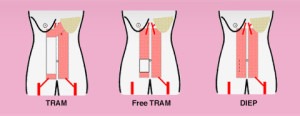 There are many myths about the DIEP flap operation. One of these is that it is a new operation and has not stood up against the test of time. Considering that the DIEP flap has been around for well over 20 years, it is safe to say that this is nothing more than a myth. In the following blog, I will present a brief history of the DIEP flap, based not on my opinions, but on reports derived from the literature.
There are many myths about the DIEP flap operation. One of these is that it is a new operation and has not stood up against the test of time. Considering that the DIEP flap has been around for well over 20 years, it is safe to say that this is nothing more than a myth. In the following blog, I will present a brief history of the DIEP flap, based not on my opinions, but on reports derived from the literature.
The first report that I can find of the DIEP flap was published in 1989 by one of the leaders in Microsurgery, Dr. Isao Koshima. In his paper titled “Inferior epigastric artery skin flaps without rectus abdominis muscle,” he describes the concerns with the traditional TRAM flap (a hernia, abdominal wall weakness, etc.) and the need for a better way to harvest the skin and fat from the lower abdomen for use in breast reconstruction. He goes on to describe the technique for harvesting the same skin and fat from the lower abdomen that is used in the TRAM flap, but without incorporating the six-pack (rectus) muscle. To prove its utility, the authors also report the use of this rectus muscle-sparing method on two patients.
Only a few years later, in 1994, Dr. Robert Allen published his experience with this new (and yes, back then, it was still “new”) procedure. He called it the deep inferior epigastric perforator flap, or DIEP flap as it’s now known. This paper profiled 15 breasts in which the DIEP flap was used for breast reconstruction and recognized that the technique “has all of the advantages of the free TRAM flap with the decreased possibility of a ventral hernia or muscle weakness.”

That was over 20 years ago. Since then, the literature has been ablaze with hundreds of publications on the use of the DIEP flap for breast reconstruction. A search on the most commonly used search engine for medical literature, PubMed, for the phrase “DIEP flap” reveals that over 300 articles have been published since 1989. This would indicate that there is widespread interest in the operation and that it has been the center of much research.
While there are no concrete definitions to objectively prove if something is “new” or “experimental,” it seems that the DIEP flap is neither of these things. In 2014, Dr. Allen published a paper titled “The evolution of perforator flap breast reconstruction: twenty years after the first DIEP flap.” In this paper, he uses his personal logbook of microsurgical cases to reflect on the DIEP flap and the several other types of flaps that have been developed since its discovery. Based on his series of over 2,800 microsurgical breast reconstructions, he concludes that in his practice, “the DIEP flap has remained the first choice in autologous breast reconstruction.” It’s difficult to argue with 20 years of experience and thousands of cases.
References:
1. Koshima I, Soeda S. Inferior epigastric artery skin flaps without rectus abdominis muscle. Br J Plast Surg. 1989 Nov;42(6):645-8.
2. Allen RJ, Treece P. Deep inferior epigastric perforator flap for breast reconstruction. Ann Plast Surg. 1994 Jan;32(1):32-8.
3. Healy C, Allen RJ Sr. The evolution of perforator flap breast reconstruction: twenty years after the first DIEP flap. J Reconstr Microsurg. 2014 Feb;30(2):121-5.

Comments are closed here.